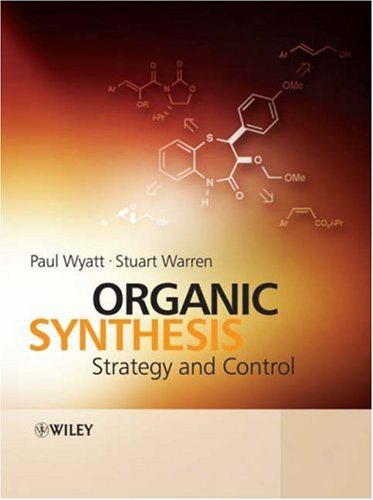- Katılım
- 14 Kas 2005
- Mesajlar
- 4,569
- Reaction score
- 0
- Puanları
- 0
rganic Synthesis: Strategy and Control
Paul Wyatt, Stuart Warren
ISBN: 978-0-471-92963-5
Paperback
918 pages
April 2007
DESCRIPTION
Organic Synthesis: Strategy and Control is the long-awaited sequel to Stuart Warren’s bestseller Organic Synthesis: The Disconnection Approach, which looked at the planning behind the synthesis of compounds. This unique book now provides a comprehensive, practical account of the key concepts involved in synthesising compounds and focuses on putting the planning into practice.
The two themes of the book are strategy and control: solving problems either by finding an alternative strategy or by controlling any established strategy to make it work. The book is divided into five sections that deal with selectivity, carbon-carbon single bonds, carbon-carbon double bonds, stereochemistry and functional group strategy.
* A comprehensive, practical account of the key concepts involved in synthesising compounds
* Takes a mechanistic approach, which explains reactions and gives guidelines on how reactions might behave in different situations
* Focuses on reactions that really work rather than those with limited application
* Contains extensive, up-to-date references in each chapter
Students and professional chemists familiar with Organic Synthesis: The Disconnection Approach will enjoy the leap into a book designed for chemists at the coalface of organic synthesis.
TABLE OF CONTENTS
A: Introduction: Selectivity.
1. Planning Organic Syntheses: Tactics, Strategy, and Control.
2. Chemoselectivity.
3. Regioselectivity: Controlled Aldol Reactions.
4. Stereoselectivity: Stereoselective Aldol Reactions.
5. Alternative Strategies for Enone Synthesis.
6. Choosing a Strategy : The Synthesis of cyclopentenones.
B: Making Carbon-Carbon Bonds.
7. The Ortho Strategy for Aromatic Compounds.
8. δ-Complexes of Metals.
9. Controlling the Michael Reaction.
10. Specific Enol Equivalents.
11. Extended Enolates.
12. Allyl Anions.
13. Homoenolates.
14. Acyl Anion Equivalents.
C: Carbon-Carbon Double Bonds.
15. Synthesis of Double Bonds of Defined Stereochemistry.
16. Stereo-Controlled Vinyl Anion Equivalents.
17. Electrophilic Attack on Alkenes.
18. Vinyl Cations: Palladium-Catalysed C–C Coupling.
19. Allyl Alcohols: Allyl Cation Equivalents (and More).
D: Stereochemistry.
20. Control of Stereochemistry — Introduction.
21 Controlling Relative Stereochemistry.
22. Resolution.
23. The Chiral Pool.
24. Asymmetric Induction I: Reagent-Based Strategy.
25. Asymmetric Induction II: Asymmetric Catalysis: Formation of C-O and C-N Bonds.
26. Asymmetric Induction III: Asymmetric Catalysis: Formation of C-H and C-C Bonds.
27. Asymmetric Induction IV: Substrate-Based Strategy.
28. Kinetic Resolution.
29. Enzymes: Biological Methods in Asymmetric Synthesis.
30. New Chiral Centres from Old.
31. Strategy of Asymmetric Synthesis.
E: Functional Group Strategy.
32. Functionalisation of Pyridine.
33. Oxidation of Aromatic Compounds, Enols and Enolates.
34. Functionality and Pericyclic Reactions: Nitrogen Heterocycles by Cycloadditions and Sigmatropic Rearrangements.
35. Synthesis and Chemistry of Azoles and other Heterocycles with Two or more Heteroatoms.
36. Tandem Organic Reactions.
General References.
Index.
http://rapidshare.com/files/4188982..._WYATT__Stuart_WARREN_-_Wiley__2007_.pdf.html

Paul Wyatt, Stuart Warren
ISBN: 978-0-471-92963-5
Paperback
918 pages
April 2007
DESCRIPTION
Organic Synthesis: Strategy and Control is the long-awaited sequel to Stuart Warren’s bestseller Organic Synthesis: The Disconnection Approach, which looked at the planning behind the synthesis of compounds. This unique book now provides a comprehensive, practical account of the key concepts involved in synthesising compounds and focuses on putting the planning into practice.
The two themes of the book are strategy and control: solving problems either by finding an alternative strategy or by controlling any established strategy to make it work. The book is divided into five sections that deal with selectivity, carbon-carbon single bonds, carbon-carbon double bonds, stereochemistry and functional group strategy.
* A comprehensive, practical account of the key concepts involved in synthesising compounds
* Takes a mechanistic approach, which explains reactions and gives guidelines on how reactions might behave in different situations
* Focuses on reactions that really work rather than those with limited application
* Contains extensive, up-to-date references in each chapter
Students and professional chemists familiar with Organic Synthesis: The Disconnection Approach will enjoy the leap into a book designed for chemists at the coalface of organic synthesis.
TABLE OF CONTENTS
A: Introduction: Selectivity.
1. Planning Organic Syntheses: Tactics, Strategy, and Control.
2. Chemoselectivity.
3. Regioselectivity: Controlled Aldol Reactions.
4. Stereoselectivity: Stereoselective Aldol Reactions.
5. Alternative Strategies for Enone Synthesis.
6. Choosing a Strategy : The Synthesis of cyclopentenones.
B: Making Carbon-Carbon Bonds.
7. The Ortho Strategy for Aromatic Compounds.
8. δ-Complexes of Metals.
9. Controlling the Michael Reaction.
10. Specific Enol Equivalents.
11. Extended Enolates.
12. Allyl Anions.
13. Homoenolates.
14. Acyl Anion Equivalents.
C: Carbon-Carbon Double Bonds.
15. Synthesis of Double Bonds of Defined Stereochemistry.
16. Stereo-Controlled Vinyl Anion Equivalents.
17. Electrophilic Attack on Alkenes.
18. Vinyl Cations: Palladium-Catalysed C–C Coupling.
19. Allyl Alcohols: Allyl Cation Equivalents (and More).
D: Stereochemistry.
20. Control of Stereochemistry — Introduction.
21 Controlling Relative Stereochemistry.
22. Resolution.
23. The Chiral Pool.
24. Asymmetric Induction I: Reagent-Based Strategy.
25. Asymmetric Induction II: Asymmetric Catalysis: Formation of C-O and C-N Bonds.
26. Asymmetric Induction III: Asymmetric Catalysis: Formation of C-H and C-C Bonds.
27. Asymmetric Induction IV: Substrate-Based Strategy.
28. Kinetic Resolution.
29. Enzymes: Biological Methods in Asymmetric Synthesis.
30. New Chiral Centres from Old.
31. Strategy of Asymmetric Synthesis.
E: Functional Group Strategy.
32. Functionalisation of Pyridine.
33. Oxidation of Aromatic Compounds, Enols and Enolates.
34. Functionality and Pericyclic Reactions: Nitrogen Heterocycles by Cycloadditions and Sigmatropic Rearrangements.
35. Synthesis and Chemistry of Azoles and other Heterocycles with Two or more Heteroatoms.
36. Tandem Organic Reactions.
General References.
Index.
http://rapidshare.com/files/4188982..._WYATT__Stuart_WARREN_-_Wiley__2007_.pdf.html


